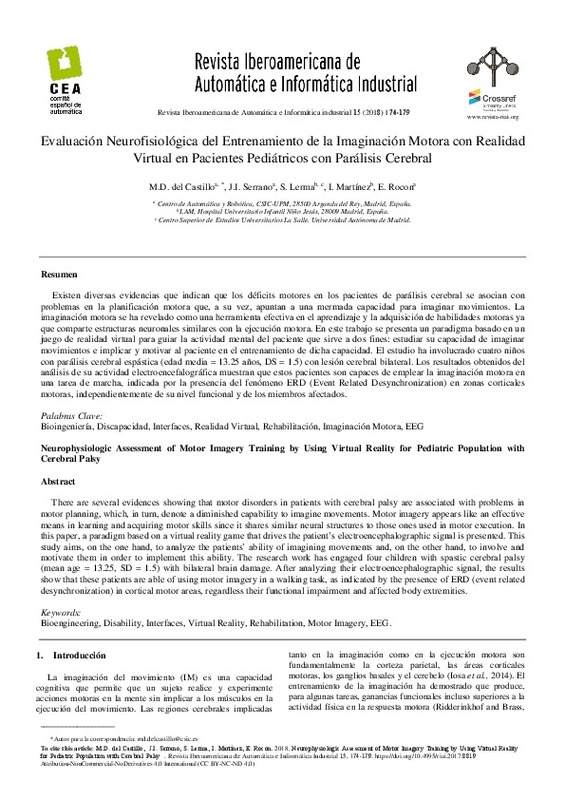Bayón, C., Ramírez, O., Serrano, J.I., del Castillo, M.D., Pérez-Somarriba, A., Belda-Lois, J.M., Martínez-Caballero, I., Lerma-Lara, S., Cifuentes, C., Frizera, A., Rocon, E., 2017. Development and evaluation of a novel robotic platform for gait rehabilitation in patients with cerebral palsy: CPWalker. Robotics and Autonomous Systems, 91, 101-114. https://doi.org/10.1016/j.robot.2016.12.015
Blair, E., 2010. Epidemiology of the cerebral palsies. Orthopedic Clinics of North America, 41, 441-55. https://doi.org/10.1016/j.ocl.2010.06.004
Chang, M.C., Kim, D.Y., Park, D.H., 2015. Enhancement of cortical excitability and lower limb motor function in patients with stroke by transcranial direct current stimulation. Brain Stimulation, 8(3), 561-566. https://doi.org/10.1016/j.brs.2015.01.411
[+]
Bayón, C., Ramírez, O., Serrano, J.I., del Castillo, M.D., Pérez-Somarriba, A., Belda-Lois, J.M., Martínez-Caballero, I., Lerma-Lara, S., Cifuentes, C., Frizera, A., Rocon, E., 2017. Development and evaluation of a novel robotic platform for gait rehabilitation in patients with cerebral palsy: CPWalker. Robotics and Autonomous Systems, 91, 101-114. https://doi.org/10.1016/j.robot.2016.12.015
Blair, E., 2010. Epidemiology of the cerebral palsies. Orthopedic Clinics of North America, 41, 441-55. https://doi.org/10.1016/j.ocl.2010.06.004
Chang, M.C., Kim, D.Y., Park, D.H., 2015. Enhancement of cortical excitability and lower limb motor function in patients with stroke by transcranial direct current stimulation. Brain Stimulation, 8(3), 561-566. https://doi.org/10.1016/j.brs.2015.01.411
Crajé, C., van Elk, M., Beeren, M., van Schie, H.T., Bekkering, H., Steenbergen, B., 2010. Compromised motor planning and motor imagery in right hemiparetic cerebral palsy. Research in Developmental Disabilities, 3186, 1313-1322. https://doi.org/10.1016/j.ridd.2010.07.010
Iosa, M., Zocolillo, L., Montesi, M., Morelli, D., Paolucci, S., Fusco, A., 2014. The brain's sense of walking: a study on the intertwine between locomotor imagery and internal locomotor models in healthy adults, typically developing children and children with cerebral palsy. Frontiers in Human Neuroscience, 8(359), 1-9. https://doi.org/10.3389/fnhum.2014.00859
Labruyère, R., Gerber, C.N., Birrer‐Brütsch, K., Meyer‐Heim, A., van Hedel, H., 2013. Requirements for and impact of a serious game for neuro‐pediatric robot‐assisted gait training. Research in Developmental Disabilities, 34, 3906-3915. https://doi.org/10.1016/j.ridd.2013.07.031
Laver, K., George, S., Thomas, S., Deutsch, JE., Crotty, M., 2012. Cochrane review: virtual reality for stroke rehabilitation. European Journal of Physical and Rehabilitation Medicine, 48(3), 523-530.
Lerma, S., del Castillo, M.D., Serrano, J.I., Rocon, E., Raya, R., Martínez, I., 2015. EEG control of gait in children with cerebral palsy. Preliminary data for the construction of a brain computer interface. Gait & Posture 42, S42. https://doi.org/10.1016/j.gaitpost.2015.06.082
Meyer-Heim, A., van Hedel, HJA., 2013. Robot-assisted and computer-enhanced therapies for children with cerebral palsy: current state and slinical implementation. Seminars in Pediatric Neurology, 02, 139-145. https://doi.org/10.1016/j.spen.2013.06.006
Mullen, T., Kothe, C., Chi, Y.M., Ojeda, A., Kerth, T., Makeig, S., Cauwenberghs, G., Jung, T.-P., 2013. Real-time modeling and 3d visualization of source dynamics and connectivity using wearable EEG. In Procceedings of IEEE EMBS, 2013, pp. 2184-2187.
Mutsaarts, M., Steenbergen, B., Bekkering, H., 2007. Impaired motor imagery in right hemiparetic cerebral palsy. Experimental Brain Research, 172, 151-162. https://doi.org/10.1007/s00221-005-0327-0
Niazi, I.K., Mrachacz-Kersting, N., Jiang, N., Dremstrup, K., Farina, D., 2012. Peripheral electrical stimulation triggered by self-paced detection of motor intention enhances motor evoked potentials. IEEE Transactions on Neural Systems and Rehabilitation Engineering, 20(4), 595-604. https://doi.org/10.1109/TNSRE.2012.2194309
Pfurtscheller, G., da Silva, F. H. L. 1999. Event-related EEG/EMG synchronization and desynchronization: basic principles, Clinical Neurophysiology, 110, 1842-1857. https://doi.org/10.1016/S1388-2457(99)00141-8
Ridderinkhof, KR., Brass, M., 2015. How kinesthetic motor Imagery works: a predictive-processing theory of visualization in sports and motor expertise. Journal of Physiology, 109, 35-63. https://doi.org/10.1016/j.jphysparis.2015.02.003
Rose, FD., Brooks, BM., Rizzo A., 2005. Virtual reality in brain damage rehabilitation: review. Cyberpsychology Behavior, 8(3), 241-62. https://doi.org/10.1089/cpb.2005.8.241
Sharma, N., Baron, JC., 2013. Does motor imagery share neural networks with executed movement: a multivariate fMRI analysis. Frontiers in Human Neuroscience, 7:564. https://doi.org/10.3389/fnhum.2013.00564
Shin, Y.K., Lee, D.R., Hwang, H.J., You, S.J., Im, C.H., 2012. A novel EEG-based brain mapping to determine cortical activation patterns in normal children and children with cerebral palsy during motor imagery tasks. Neurorehabilitation, 31(4), 349-355. DOI: 10.3233/NRE-2012-00803
Spruijt, S., ven der Kamp, J., Steenbergen, B., 2015. Current insights in the development of children's motor imagery ability. Research in Developmental Disabilities, 34, 4154-60. https://doi.org/10.1016/j.ridd.2013.08.044
Weiss, P.L., Keshner, EA., Levin, M.F. (eds.), 2014. Virtual Reality for Physical and Motor Rehabilitation, Springer. https://doi.org/10.1007/978-1-4939-0968-1
Winkler, I., Haufe, S., Tangermann, M., 2011. Automatic classification of artifactual ICA-Components for artifact removal in EEG signals. Behavioral and Brain Functions, 7(30), 1-15. https://doi.org/10.1186/1744-9081-7-30
You, S.H., Jang, S.H., Kim, Y.H., Hallett, M., Ahn, S.H., Kwon, Y.H., Kim, J.H, Lee, M.Y., 2005. Virtual reality-induced cortical reorganization and associated locomotor recovery in chronic stroke: an experimenter-blind randomized study. Stroke, 36(6), 1166-1171. https://doi.org/10.1161/01.STR.0000162715.43417.91
[-]








